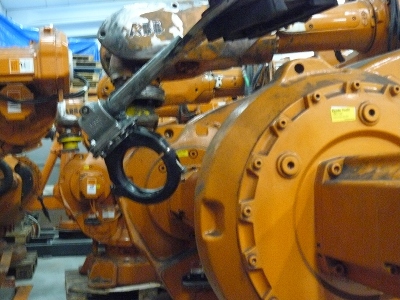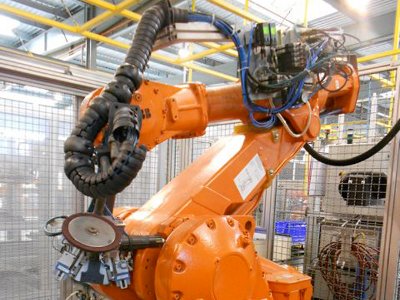

ROBOTISED WELDING
Welding is one of the paradigmatic processes carried out by Industrial Robots: in just a few years this process has gone from representing 25% of the tasks carried out by industrial robots to the 45% it occupies today. Half of these robots carry out spot welding, leaving other methods such as electric arc or laser welding far behind.
The refurbished industrial robot automates welding by improving precision, significantly reducing the working time per project and the uncertainty that deadlines entail in traditional circumstances, while significantly increasing safety in the workplace.
Welding with second-hand industrial robots involves adapting the environment to the new way of working and instrumentation, as is the case with so many other tools: the outcome will depend on the way this work is carried out.
Welding with used industrial robotic arms allows the handling of high temperatures and hazardous materials or tools in a safer environment for people. Manpower will still be required, although it will perform different tasks, such as programming the robotic arm controller or working in collaboration with it, depending on the case, establishing or adapting the work parameters in each case by means of a teach pendant. Work safety is one of the fundamental reasons for the use of industrial robots in production centers, hence automated systems include numerous safety systems to protect people and equipment.
As a result, second-hand industrial robots automate processes, guaranteeing not only increased speed, but also precision and a significant reduction in material waste. Depending on the integrated equipment, industrial robots are suitable for a wide range of welding processes:
ELECTRIC ARC WELDING
One of the most common types of welding with industrial robots is electric arc welding: an electric arc generates extreme heat that melts the metal. Arc welding is ideal when large volumes of high-precision welding are required.
RESISTANCE WELDING
When projects require heat treatment, one way to limit costs is to use resistance welding: it joins parts by melting them together, without the need for filler material.
SPOT WELDING
When the material to be welded is resistant to electrical currents, this variety of resistance welding, often used in the automotive industry, is used. This form of welding produces strong joints on small surfaces.
LASER WELDING
Laser welding joins by fusion, by heating the parts to be joined and then applying pressure to them, usually without the addition of material. Laser welding is preferred when the molecular structure of the materials must be kept as intact as possible, such as in the case of small parts or special metals. An inert gas is normally used to protect these types of joints.
TIG WELDING
TIG welding (Tungsten Inert Gas or tungsten arc welding) is of particular interest when a high level of strength and corrosion resistance is required. TIG welding is used to join ferrous and non-ferrous metals. The high precision of its joints is also remarkable, as there is hardly any deformation around the weld. TIG welds are clean, ductile and treatable after welding, which also helps to reduce costs.
PLASMA WELDING
Plasma Arc Welding (PAW) offers great flexibility as the speed of the gas passing through the nozzle and the temperature can be easily changed. It can be considered a type of TIG welding, as it is an electric arc welding established between a tungsten electrode and the metal to be welded: PAW differs from TIG in that its impact affects an area up to three times smaller, making it an optimal technique for welding in small thicknesses. A very high temperature gas is used to support the electrode, and a second gas is used to protect the joint from the atmosphere.
MIG/MAG WELDING
Metal arc welding with protective gas with consumable electrode, also known as GMAW or MIG, is a very versatile, resistant and fast method of arc welding using an electrode formed by a continuous wire - solid or tubular - and the parts to be joined. An inert gas (MIG) or active gas (MAG) protects the weld from the surrounding atmosphere. Designed for joining non-ferrous metals, it is also used for joining steel. Its ability to join in any position and at high speed makes this form of joining a versatile option.
There is a growing need to upgrade traditional manufacturing processes to the automated environment: it is key to the competitiveness of companies today and will be even more so in the future, as demonstrated by the growing importance of industrial robots worldwide. The lack of updating and modernisation of processes, linked to the need to adjust costs, has for decades led to the relocation of production sites and small and medium-sized companies to an ever-increasing competitive imbalance: a highly productive and consistent solution at all levels lies in the automation of all those processes that make it possible to adjust costs and increase competitiveness.
Robots Gallery buys, refurbishes and sells used industrial robots across the globe. Through recycling and reuse we provide an average saving of 45% on the investment in industrial robots, providing equipment with a long life ahead of it, fully functional, guaranteed, and amortizable in more affordable terms. Furthermore, working with the best welding specialists, we offer second-hand industrial robots already equipped for welding and we provide our customers with contact with engineering companies specialised in the execution of turnkey robotic welding products: whatever you may need, we will find a suitable solution.


